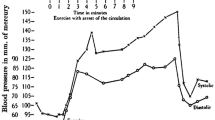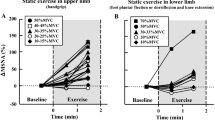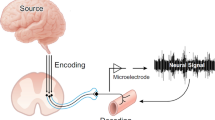Abstract
This review focuses on the role afferent nerves from the contracting muscles play in linking muscle metabolism to the cardiovascular adjustments during exercise by means of a ‘muscle chemoreflex’. In the 1930s Alam and Smirk provided the first clear evidence that human (and animal) skeletal muscles are innervated by chemosensitive afferents that can evoke increases in arterial blood pressure. They proposed that the purpose of the increase in pressure was to improve blood flow to the active muscles. Subsequent studies have identified the slowly conducting group IV afferents as the major class of fibres participating in the sensory arm of this reflex. Most of these fibres travel via the dorsal roots to the ipsilateral spinal cord where they synapse in the substantia gelatinosa and release substance P or other peptide transmitters. The second order (or higher) neurons cross to the contralateral side of the spinal cord and travel rostrally to stimulate brainstem cardiovascular centres and increase arterial pressure. Current evidence favours the concept that substances associated with muscle acidosis provide the stimulus to the afferents. In humans, chemosensitive afferent activation causes a marked increase in vasoconstrictor efferent muscle sympathetic nerve activity. It is unclear if the muscle chemoreflex improves blood flow to ‘underperfused’ active muscles by augmenting arterial pressure, or if the increase in sympathetic outflow restrains metabolic vasodilatation to regulate arterial blood pressure during activities like running or cycling.
Similar content being viewed by others
References
Asmussen E. Exercise: general statement of unsolved problems.Circ Res 1967;20: 12–15 (suppl).
Rowell LB, Sheriff DD. Are muscle ‘chemoreflexes’ functionally important?NIPS 1988;3: 250–253.
Alam M, Smirk FH. Observations in man upon a blood pressure raising reflex arising from the voluntary muscles.J Physiol Lond 1937;89: 372–383.
Alam M, Smirk FH. Unilateral loss of a blood pressure raising, pulse accelerating, reflex from voluntary muscle due to a lesion of the spinal cord.Clin Sci 1938;3: 247–252.
Mitchell JH, Schmidt RF. Cardiovascular reflex control by afferent fibers from skeletal muscle receptors. In: Shepherd JT, Abboud FM, eds.Handbook of Physiology. Peripheral Circulation and Organ Blood Flow, Part 2. Bethesda: American Physiological Society, 1983; 623–658.
Hobbs SF, McCloskey DI. Effects of blood pressure on force production in cat and human muscle.J Appl Physiol 1987;63: 834–839.
Hobbs SF. Central command during exercise: parallel activation of the cardiovascular and motor systems by descending command signals.Developments in Neuroscience 1982;15: 217–231.
McCloskey DI, Mitchell JH. Reflex cardiovascular and respiratory responses originating in exercising muscle.J Physiol Lond 1972;224: 173–186.
Tibes U. Reflex inputs to the cardiovascular and respiratory centers from dynamically working canine muscles.Circ Res 1977;41: 332–341.
Kaufman MP, Rotto DM, Rybicki KJ. Pressor reflex response to static muscular contraction: its afferent arm and possible neurotransmitters.Am J Cardiol 1988;62: 58E-62E.
Rotto DM, Stebbins CL, Kaufman MP. Reflex cardiovascular and ventilatory responses to increasing H+ activity in cat hindlimb muscle.J Appl Physiol 1989;67: 256–263.
Victor RG, Bertocci LA, Pryor SL, Nunnally RL. Sympathetic nerve discharge is coupled to muscle cell pH during exercise in humans.J Clin Invest 1988;82: 1301–1305.
Ettinger S, Gray K, Whisler S, Sinoway L. Dichloroacetate reduces sympathetic nerve responses to static exercise.Am J Physiol (Heart Circ Physiol 30) 1991;261: H1653-H1658.
Pryor SL, Lewis SF, Haller RG, Bertocci LA, Victor RG. Impairment of sympathetic activation during static exercise in patients with muscle phosphorylase deficiency (McArdle's disease).J Clin Invest 1990;85: 1444–1449.
Lundberg JM, Lundblad L, Martling C-R, Saria A, St Järne P, Änggård A. Coexistence of multiple peptides and classic transmitters in airway neurons: functional and pathophysiologic aspects.Am Rev Respir Dis 1987;136: S16-S22.
Lundblad L, Hua X-Y, Lundberg JM. Mechanisms for reflexive hypertension induced by local application of capsaicin and nicotine to the nasal mucosa.Acta Physiol Scand 1984;121: 277–282.
Sinoway LI, Rea RF, Mosher TJ, Smith MB, Mark AL. Hydrogen ion concentration is not the sole determinant of muscle metaboreceptor responses in humans.J Clin Invest (in press).
Sterns DA, Ettinger SM, Gray KS, Whisler SK, Mosher TJ, Smith MB, Sinoway LI. Skeletal muscle metaboreceptor exercise responses are attenuated in heart failure.Circulation 1991;84: 2034–2039.
Yaksh TL. Neurologic mechanisms of pain. In: Cousins MJ, Bridenbaugh PO, eds.Neural Blockade in Clinical Anesthesia and Management of Pain. Philadelphia: JB Lippincott Co, 1988; 791–844.
Hill JM, Kaufman MP. Attenuation of reflex pressor and ventilatory responses to static muscular contraction by intrathecal opioids.J Appl Physiol 1990;68: 2466–2472.
Pomeroy G, Ardell JL, Wurster RD. Spinal opiate modulation of cardiovascular reflexes in the exercising dog.Brain Res 1986;381: 385–389.
Sato A. Spinal and medullary reflex components of the somato-sympathetic reflex discharges evoked by stimulation of the group IV somatic afferents.Brain Res 1973;51: 307–318.
Mark AL, Victor RG, Nerhed C, Wallin BG. Microneurographic studies of the mechanisms of sympathetic nerve responses to static exercise in humans.Circ Res 1985;57: 461–469.
Victor RG, Seals DR, Mark AL. Differential control of heart rate and sympathetic nerve activity during dynamic exercise.J Clin Invest 1987;79: 508–516.
Seals DR. Influence of muscle mass on sympathetic neural activation during isometric exercise.J Appl Physiol 1989;67: 1801–1806.
Seals DR, Victor DG. Regulation of muscle sympathetic nerve activity during exercise in humans. In: Holloszy JO, ed.Exercise and Sport Sciences Reviews. Baltimore: Williams & Wilkins, 1991; 313–349.
Victor RG, Pryor SL, Secher NH, Mitchell JH. Effects of partial neuromuscular blockade on sympathetic nerve responses to static exercise in humans.Circ Res 1989;65: 468–476.
Asmussen E. Similarities and dissimilarities between static and dynamic exercise.Circ Res 1981;48: I3-I10 (suppl).
Lorentsen E. Systemic arterial blood pressure during exercise in patients with atherosclerosis obliterans of the lower limbs.Circulation 1972;46: 257–263.
Rowell LB, O'Leary DS. Reflex control of the circulation during exercise: chemoreflexes and mechanoreflexes.J Appl Physiol 1990;69: 407–418.
Wyss CR, Ardell JL, Scher AM, Rowell LB. Cardiovascular responses to graded reductions in hindlimb perfusion in exercising dogs.Am J Physiol (Heart Circ Physiol 14) 1983;245: H481-H486.
Sheriff DD, Wyss CR, Rowell LB, Scher AM. Does inadequate oxygen delivery trigger pressor response to muscle hypoperfusion during exercise?Am J Physiol (Heart Circ Physiol 22) 1987;253: H1199-H1207.
Eiken O. Responses to dynamic leg exercise in man as influenced by changes in muscle perfusion pressure.Acta Physiol Scand 1987;131 (suppl 566): 1–37.
Joyner MJ. Does the pressor response to ischemic exercise improve blood flow to contracting muscles in humans?J Appl Physiol 1991;71: 1496–1501.
Rowell LB, Savage MV, Chambers J, Blackmon JR. Cardiovascular responses to graded reductions in leg perfusion in exercising humans.Am J Physiol (Heart Circ Physiol 30) 1991;261: H1545-H1553.
Strandell T, Shepherd JT. The effect in humans of increased sympathetic activity on blood flow to active muscles.Acta Med Scand 1967;472: 146–167 (suppl).
Joyner MJ, Lennon RL, Wedel DJ, Rose SH, Shepherd JT. Blood flow to contracting human muscles: influence of increased sympathetic activity.J Appl Physiol 1990;68: 1453–1457.
Sinoway L, Prophet S. Skeletal muscle metaboreceptor stimulation opposes peak metabolic vasodilation in humans.Circ Res 1990;66: 1576–1584.
Saltin B, Strange S. Maximal oxygen uptake: ‘old’ and ‘new’ arguments for a cardiovascular limitation.Med Sci Sports Exerc 1992;24: 30–37.
Joyner MJ, Shepherd JT. Arterial baroreceptor function and exercise. In: Persson PB, Kirchheim HR, eds.Baroreceptor Reflexes. Berlin/Heidelberg: Springer-Verlag, 191; 237–255.
Strange S, Rowell LB, Christensen NJ, Saltin B. Cardiovascular responses to carotid sinus baroreceptor stimulation during moderate to severe exercise in man.Acta Physiol Scand 1990;138: 145–153.
Author information
Authors and Affiliations
Rights and permissions
About this article
Cite this article
Joyner, M.J. Muscle chemoreflexes and exercise in humans. Clinical Autonomic Research 2, 201–208 (1992). https://doi.org/10.1007/BF01818963
Received:
Accepted:
Issue Date:
DOI: https://doi.org/10.1007/BF01818963




